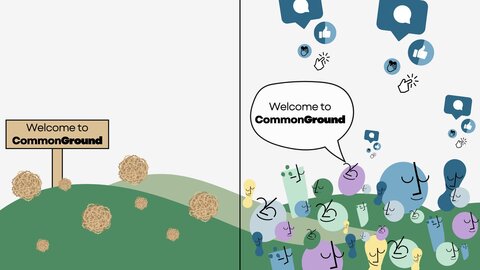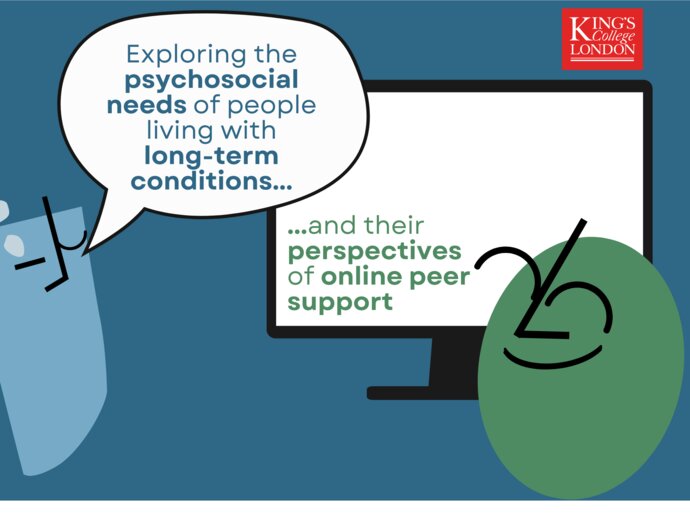CommonGround: avoiding tumbleweeds in the community

What is ‘engagement’ in online communities and what kind of engagement do we hope to observe on CommonGround?
Our team of academics, clinicians, software developers and people living with long-term conditions have created an online platform, called CommonGround. The hope is that CommonGround will be a space for a community to flourish, where people living with long-term physical conditions can connect and support one another. We also hope that the library of self-help resources will help people learn about the link between their mental and physical health, and how to live better with a long-term condition.
We are proud of the platform that we have created for the community. But this is only half the task. After all, what is the point in creating a space for an online community, if there is no community?
The problem of tumbleweed
If the community is a ghost town, users will not be able to interact with one another, find people that they relate to, or find the advice and information they may be looking for. In our research, we are trying to understand if we can realistically implement our platform in the real world. A key part of this relates to laying the foundations for a community to form and supporting it as it develops. One way our ‘engagement team’ are doing this is by collecting and curating content relevant to people living with long-term conditions that they can engage with and talk about. We are creating conversation starters for CommonGround users and posting content that users can simply browse through if they prefer. This means that the community feed will not be completely empty when our users join the brand-new community. It also means that there will be consistent content there for people to engage with if they want to, even if it takes some time before the community flourishes with original content being created by community members.
So, what should we do to help a community form?
Part of the plan for promoting an engaged community has included creating some principles which will guide the research team on what we will do, and what we won’t do to help create a community. To give an example: one of our principles states that the research team will welcome all new users who have made their first post, to encourage conversation and promote future postings. However, the research team will not engage in continuous one-to-one conversations to avoid conversations becoming user-to-engagement team than user-to-user.
But what do we mean by engagement?
We realised early on that we might have to think about user engagement a bit differently to bigger social media platforms, and the common ‘the more the better’ view that ‘the more time spent logged in and the greater the visible activity, the higher the engagement’. In fact, it’s important we have a different definition of engagement, as our users may benefit from using CommonGround, regardless of how they choose to interact and how often. We are also more than a platform for socialising, CommonGround specifically aims to support users in their psychological wellbeing and self-management of their condition, alongside participating in peer support.
The online community we are building is also designed to cater for people who may not all be comfortable or familiar with some digital technologies or websites. We would like CommonGround to be a home for anyone with a long-term condition who wants to improve their emotional wellbeing, even if they have never joined an online community before or don’t use social media. We would expect that these users might use the platform very differently to regular social media or internet users. For instance, they may take longer to explore and understand the features of the platform (e.g., how to create the post) and to build their confidence in creating their own content.
So, how did we decide to define engagement for CommonGround?
With all of this in mind, we have defined engagement as:
any measurable activity that a user undertakes on CommonGround, including reading, reacting to, and responding to posts, as well as creating new content, editing their profile, following other users
In our definition, a user can be engaged regardless of their volume of activity or length of time spent logged in or posting. By including all different types of activity in our definition, we are acknowledging how engagement can look different for each user. The way users decide to engage with the platform is not simply dictated by their opinion of the platform, but also may be dependent on many factors such as their health needs, technological confidence, and motivation for joining the community.
Theories of engagement also suggest that out of a group of 100 users, 90% of them will observe and not publicly interact or comment often, 9% of them will comment or contribute content occasionally, and 1% user will regularly create content [1, 2]. By having a broad definition of engagement, we are acknowledging that engagement can look very different for each user. However, as we know that some people (potentially 9 out of 10 users as the 90-9-1 theory predicts) might prefer to only read through content – we therefore need to make sure that there is content on the platform for people to engage with in this way. If we were to rely solely on the community to create this content (potentially 1 out of 10 users), especially as the new community finds its feet, there may not be enough content. If those looking to mainly read through content cannot find enough to read, they might not be motivated to login again in the future. Our engagement plan therefore should consider the needs of all of our users, taking into account the range of different engagement behaviours.
Discussions with our Patient Public Involvement group, our panel of people with lived experience who collaborate on our research with us, shed some further light into engagement to help us develop our final engagement plan. Our members shared with us that when they are new to a community, they feel most comfortable engaging with content that is already posted in the community, rather than creating their own content. If we have posts shared by the engagement team available for people to comment on when they join, this might encourage people to begin speaking. They also told us that, as CommonGround is new, we might need to remind people that it exists! Sharing reminders via email that they recently signed up to CommonGround may help people form habits around logging into the platform. Together, considering theories of engagement, predicting how our users may behave, and discussions with our patient public involvement group have helped steer our path.
A plan to satisfy users
We have considered the different types of users we might see on CommonGround, and so wanted to create our engagement plan to support all users. We have also taken into consideration that our community is brand new with all users joining at the same time. Here are some key elements that we have been included in our engagement plan…
As we know some people may engage by mainly reading, reacting, or commenting, In addition to those who may be keen to create their own content, we wanted our plan to also satisfy those users who may engage by mainly reading, reacting and/or commenting. As we are launching a new community, we also needed to consider this in our plan.
Reminding users that CommonGround exists:
As we are a new platform it is important for us to remind users that the community exists! Therefore, to remind people to visit the platform, we will send emails with recaps of what’s happening on CommonGround to encourage users to log in, as well as check in with users that have not logged in recently.
Promoting engagement: We want there to be content for those who largely prefer to read through content, or react and comment, and who may never choose to create their own posts. Therefore, we have created a calendar of relevant content that the research team will start discussions on. Each of the weekly themes represents an area of shared importance to people with long-term conditions like ‘maintaining relationships’ and ‘keeping active while living with a health condition’.
It is important to emphasise that these activities will happen alongside the natural discussions that form on the platform, and our plan can adapt over time to suit the community – ultimately the community culture will be created and maintained by people living with long-term conditions, we are here as the engagement team to get the ball rolling and support as needed.
A success in avoiding tumbleweed?
So, we have our definition, we have a plan for driving engagement in the community. However, our task is far from finished. As well as implementing the engagement plan, we also want to measure how people are engaging with CommonGround during the three-month intervention. Answering the question of “how are people engaging with CommonGround?” will help us understand the next steps our research should take, and indeed, if a platform like ours is needed and wanted by people in the real world. We know that our definition of engagement is different to how other social media platforms might define engagement. It follows that we will also be measuring engagement in a different way. As well as considering data usage metrics, such as the number of logins or time spent logged in, we will have to measure the other aspects of engagement on CommonGround. In our next blog, we share our journey of trying to answer the question “well how can we measure the engagement of our community members?”.




